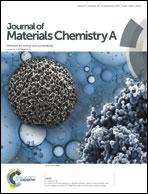Electrochemical reduction of Ag2VP2O8 composite electrodes visualized via in situ energy dispersive X-ray diffraction (EDXRD): unexpected conductive additive effects†
Abstract
In this study, we characterize the deposition of silver metal nanoparticles formed during discharge of Li/Ag2VP2O8 cells with composite cathodes containing conductive carbon additive. Using in situ energy dispersive X-ray diffraction (EDXRD) of an intact battery, the location and distribution of silver metal nanoparticles generated upon reduction-displacement deposition within an Ag2VP2O8 cathode containing a pre-existing percolation network can be observed for the first time. This study yielded unexpected results where higher rate initial discharge generated a more effective conductive matrix. This stands in contrast to cells with cathodes with no conductive additive where a low rate initial discharge proved more effective. These results provide evidence that using conductive additives in conjunction with an in situ reduction-displacement deposition of silver metal provides a path toward the ultimate goal of complete electrical contact and full utilization of all electroactive particles.


 Please wait while we load your content...
Please wait while we load your content...